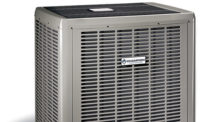Energy efficiency is unequivocally one of the most important aspects of HVAC products. That fact has remained unchanged for decades, but the manner in which energy efficiency is presented to consumers has gone through various incarnations.
The term “green” became a popular efficiency buzzword several years ago, while rebates and incentives have consistently been utilized to offset efficiency investments. Additionally, contractors have had success simply explaining the balance between the cost and return on investment when it comes to purchasing highly efficient products.
In today’s marketplace, customers are opting to educate themselves on HVAC products via the internet prior to a contractor’s arrival. A recent American Home Comfort study from Decision Analyst reinforces this revelation, reporting that, for the first time in years, homeowners are more trusting of the internet for HVAC information than they are their contractors.
And while this study had been trending in that direction for years, its results are still impactful. So, how are contractors presenting energy-efficiency to a more educated consumer base?
THE METHODOLOGY
Matthew Pillius, owner and CEO of Royal Class Service in New Windsor, New York, believes the tried-and-true process of offering rebates and any possible incentives is a reliable approach.
“If folks have a complete failure or a need for a complete replacement, then a general conversation about today’s best products is enough, but if we’re trying to incentivize them to change, then rebates tend to make the difference,” he said.
For Phil London, vice president of residential services, Thermal Concepts Inc., Davie, Florida, it is important to take a direct approach when showcasing potential savings.
“Show consumers the many resources available from vendors touting the savings on energy-efficient products and then do a quick energy calculation with the consumer based on his or her local utility bills,” he said.
Sometimes it can also come down to simply understanding how the most efficient HVAC offerings can solve comfort or health-related issues.
“We present energy-efficiency products via systematic interaction, by asking questions, and helping to uncover why the customer is interested in a product to begin with,” said Marc Tannenbaum, president of Dr. Energy Saver in Seymour, Connecticut. “What is a customer trying to fix in the house? We uncover that and then show how our products can solve their problems.”
Still, for as knowledgeable as a part of the consumer base has become, contractors still need to preach the benefits of increased efficiency.
“We list [efficiencies] in our proposals, mainly because it takes a great deal of conversation to describe how the house works as a system and explain how to calculate a Manual J load. Additionally, showing [customers] how important it is to properly size equipment generally helps, as well,” said Pillius.
Tannenbaum said, often times, it goes beyond the equipment itself.
“We are a whole-home energy contractors,” he said. “We talk to customers about Btu, distribution of Btu, how to retain Btu in the home, etc. We show them what is going on in the house and why they are unable to heat or cool an area. If they’re suffering from allergies, we show customers where their house has issues. We give demonstrations and provide a great deal of education in the home.”
UNDERSTANDING GREEN
Contractors unilaterally agree it is important to teach customers about the benefits of highly efficient HVAC products, but not all customers factor in the cost-reward balance that accompanies increasing efficiencies.
“I honestly don’t find too many consumers putting a lot of weight on the cost-reward balance,” said Pillius. “I think they understand, at this point, they are going to save money with an upgrade. I help them understand the benefits of system sizing, explain that their current equipment is likely oversized, and, with a properly sized system, they’ll probably save money right out of the package.”
Tannenbaum doesn’t see customers weighing the cost-reward balance without interaction or explanation.
“Customers buy products for emotional reasons, and then we find that customers aren’t opting for efficient materials based on savings,” he said. “It’s about fixing their problems, just as it always has been.”
A differing opinion came from London, who said customers in all markets are understanding the cost-reward benefits.
“Fixed-income families can budget more effectively,” he said. “Consumers looking to sell their homes understand that energy-efficient products are selling points.”
What may not be a selling point is touting certain products as being especially green. While the term has gained some traction throughout the industry, many insist its value may be fading, especially when it comes to older consumers.
London hasn’t found the term to be a motivating factor at all, and Pillius doesn’t think green has much play throughout the industry anymore.
“Again, I think people understand newer technologies equal cost savings, and unless we’re using renewables, I don’t think they consider fossil fuel equipment green technologies,” he said. “The same goes for heat pumps, as I don’t think they associate those as green unless there’s a solar component or a geothermal component.”
Tannenbaum thinks the term may still have something to offer, at least to younger consumers.
“Green moves the needle with younger customers and millennials,” he said. “The majority of homeowners are still baby boomers and a bit younger, and to them we don’t market green at all. We tried it four or five years ago and didn’t see much success with it. Millennials just aren’t yet a major portion of the market. Once they are, the term may gain traction once again.”
INCREASING IMPORTANCE
While the value of buzzwords may come and go, energy efficiency itself continues to be a mainstay.
“I think it’s inevitable that efficiency has to improve,” said Pillius. “I think it’s expected and not optional. Some people still want standard-efficiency equipment for various reasons, perhaps it’s budget — perhaps it’s length of time they remain in their homes, or maybe it’s their age and forecasted time remaining on this earth. Those things aside, most people understand more efficient equipment is the norm and, with time, all things improve.”
London said higher efficiencies are most important to higher-end customers who have the ability to invest in the higher-priced, high-efficiency products.
For Tannenbaum, high efficiency is simply a minimal bar contractors must overcome.
“If you are not offering Energy Star equipment, then customers may not talk to you at all,” he said. “They want efficient products and notable certifications. This is the entry-level cost of doing business. You have to provide efficient equipment. I think it’s becoming more important, even though energy costs are fairly low and still going down. Whether or not you believe in global warming, people are interested in doing what is right for their families and their communities. That awareness will only grow over time.”
Publication date: 9/26/2016
Want more HVAC industry news and information? Join The NEWS on Facebook, Twitter, and LinkedIn today!





